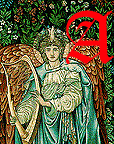
number of eminent Victorians believed in the possibility of communication with the world of spirits. Robert Owen (1771-1858), an industrialist and social reformer, became a devout spiritualist in 1853 after having witnessed a series of séances with the American medium Maria Hayden. In 1871, another medium Emma Hardinge Britten (1823-1899) claimed that she had received The 'Seven Principles of Spiritualism' from the departed Robert Owen. They were adopted as guidelines by the British National Association of Spiritualists, established in 1873. Edward Bulwer-Lytton (1803-1873), a prolific writer, had a lifelong interest in the occult and Spiritualism. His novels, Godolphin (1833), Zanoni (1842), The Haunted and the Haunters (1859), A Strange Story (1862), and The Coming Race (1871) contain references to occult and supernatural phenomena.
Some Victorians, like Florence Marryat (1833-1899), the author of There Is No Death (1891), The Clairvoyance of Bessie Williams (1893), and The Spirit World (1894), saw Spiritualism as a religion, whereas others, like Arthur Conan Doyle, considered it a science. As Helen Sword writes, William Makepeace Thackeray, Elizabeth Barrett Browning and Robert Browning, Christina Rossetti, John Ruskin, Lewis Carroll, Laurence Oliphant, Rider Haggard, Rudyard Kipling, Andrew Lang, all participated in spiritualist practices at one time or another (5)
Elizabeth Barrett Browning, who was attracted to Swedenborg's idea of the resurrection of the spiritual body, was a keen participant in Spiritualist séances. Sir William Crookes, (1832-1919), one of the most important scientists of the late 19th century, the discoverer of thallium (1861) and the inventor of the radiometer (1875), was convinced about the reality of spiritual phenomena. Likewise, Sir Oliver Lodge (1851-1940), a physicist involved in the development of wireless telegraphy, studied psychical phenomena (telepathy) in the late 1880s, and was a member of the famous Ghost Club. In his most controversial book, Raymond or Life and Death (1916), dedicated to his son, who was killed in World War One, Lodge claimed to have heard from mediums that afterlife is not much different from this life. Another outstanding Victorian intellectual, Alfred Russel Wallace (1823-1913), a co-discoverer of the theory of evolution, described his experiences of the spirit world in his book, Miracles and Modern Spiritualism (1896).
Notable opponents of Spiritualist practices included Charles Dickens, who disdained spirit mediumship, but published many articles on the subject in the Household Words. Robert Browning attended Spiritualist séances with his wife Elizabeth Barrett Browning, but was skeptical about the supernatural phenomena. George Eliot dismissed Spiritualism as “the most painful form of the lowest charlatanerie.” (153) Alfred Tennyson said: “I am convinced that God and the ghosts of men would choose something other than mere table-legs through which to speak to the heart of man.” (Cottom 24) Likewise, Anthony Trollope wrote: “But when tables rap, and boards write, and dead young women come and tickle my knee under a big table, I find the manifestations to be unworthy of the previous grand ceremony of death.” (Cottom 25)
Michael Faraday (1791-1867), a physicist and chemist, who discovered electromagnetic induction, believed that Spiritualism was a hokum. In a letter to the Times in 1853, Faraday argued that table-tilting could be effected rather by involuntary muscle movement rather than unseen spirits. However, as Georgina Byrne observes, “After Faraday had died, his 'spirit' returned to a séance to admit that he was wrong in life and that claims of spiritualism were valid.” (37) Thomas Henry Huxley (1825-1895), the famous biologist, wrote: “The only good that I can see in the demonstration of the truth of 'Spiritualism' is to furnish an additional argument against suicide. Better to live a crossing-sweeper than to die and be made to talk twaddle by a 'medium' hired at a guinea a seance.” (Sword 4)
Ghost-Written Literature
It should be noted that several books were published as automatic transcripts of messages allegedly dictated by the ghosts of deceased authors. After his death Charles Dickens, of all Victorian authors, was the most frequent target of medium communications in séance rooms. As is known, Dickens did not finish his last novel, The Mystery of Edwin Drood. In 1873, Thomas James, an American printer, completed it, claiming that Dickens's spirit had dictated it to him.
William Thomas Stead (1849-1912), a noted journalist and social reformer, announced that he had received spirit communications from the departed Julia Ames, an American temperance reformer and journalist, which he published in the book After Death or Letters from Julia (1892). In 1926, Mrs. Hester Travers Smith (1868-1949), the daughter of a distinguished Shakespearian scholar, Professor Edward Dowden, and the wife of the prominent Dublin physician, claimed that she had received a message from the spirit of Oscar Wilde and published in the book, Psychic Messages from Oscar Wilde.
Related Material
- Introduction
- Sir Arthur Conan Doyle and Victorian Spiritualism
- Bibliography
- The Séance Diary of William Michael Rossetti
Last modified 14 November 2013